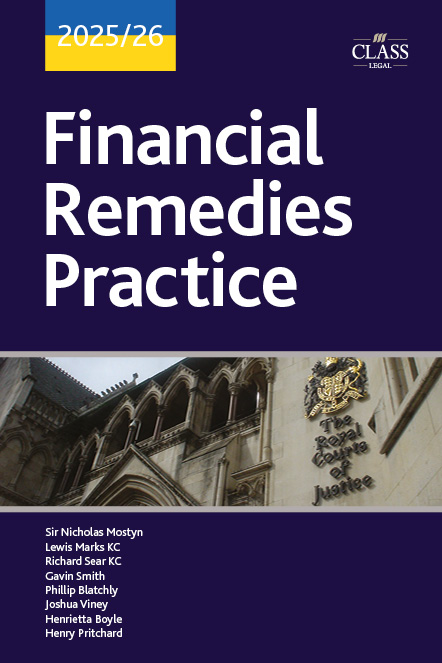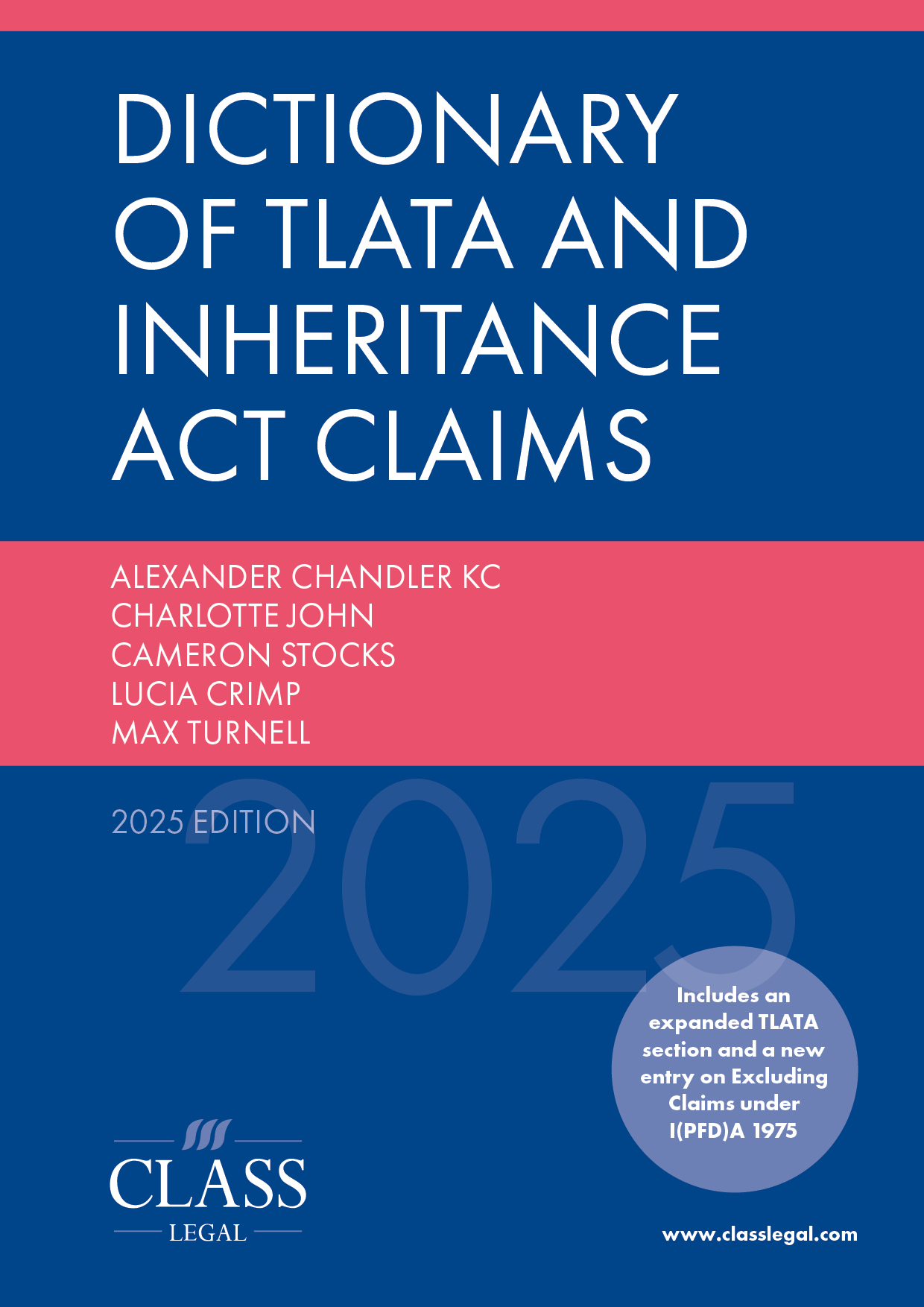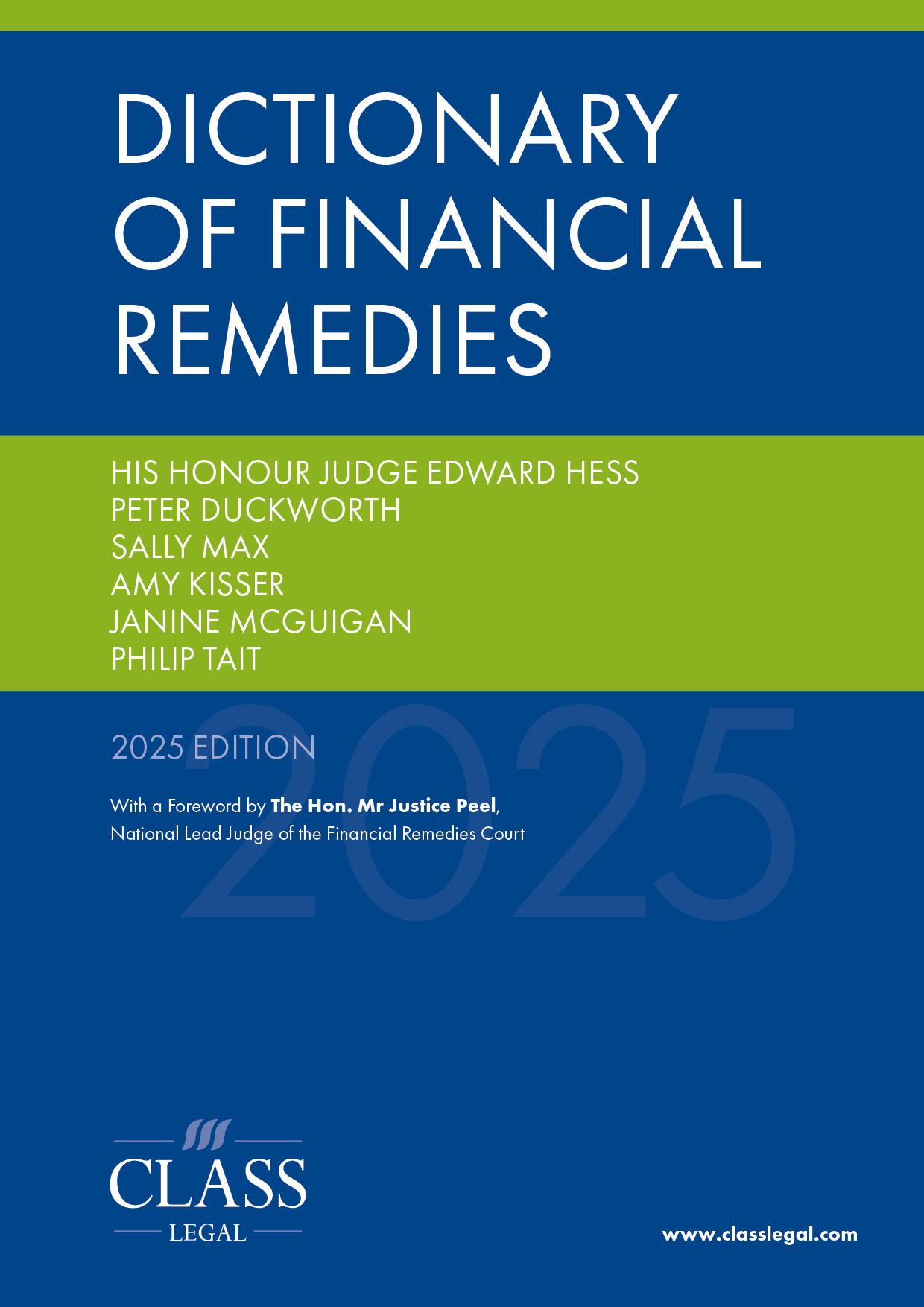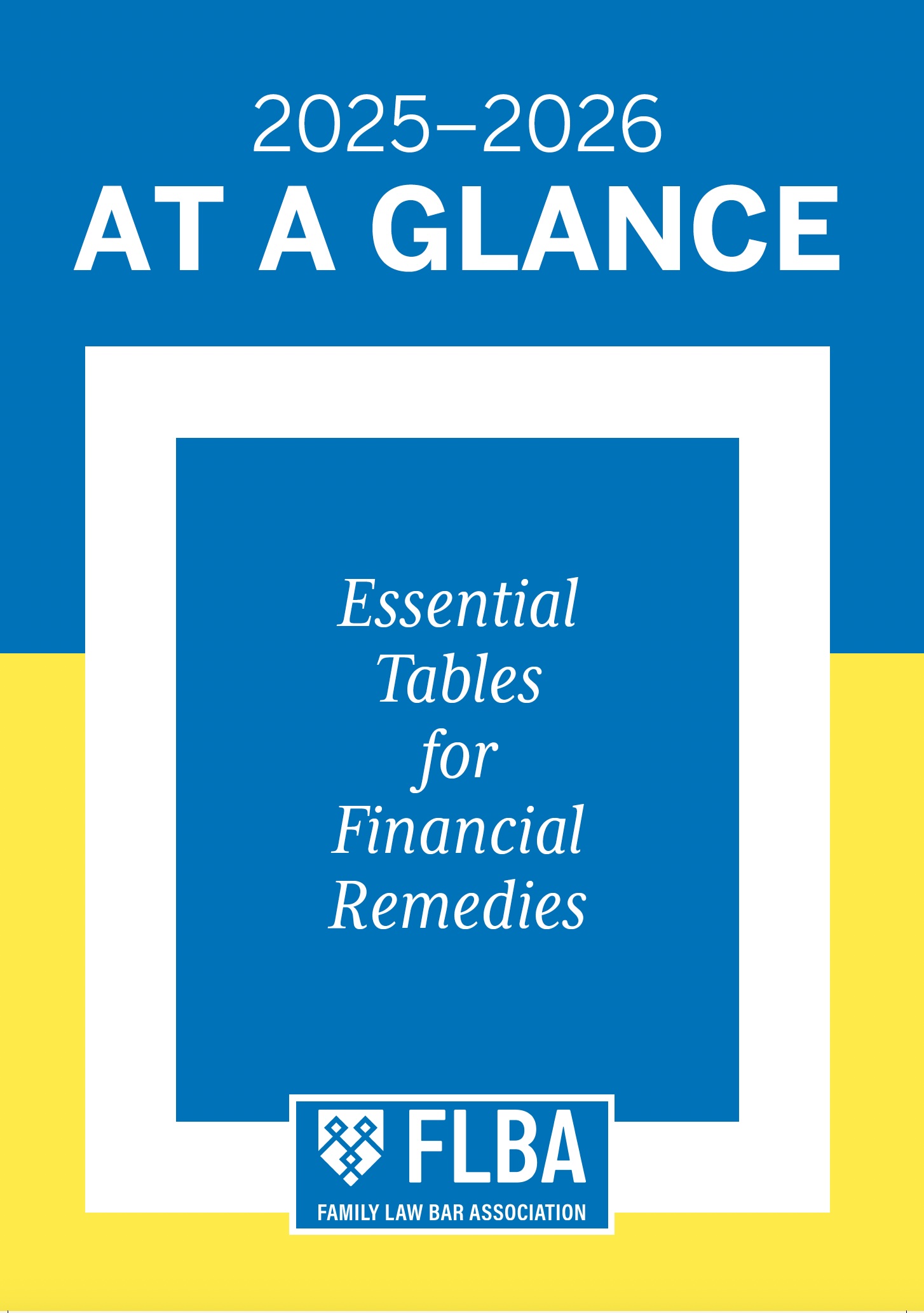
Transplanting Costs Order Principles to LSPOs and Legal Costs Funding Orders
Published: 07/04/2025 10:00

In family proceedings, the court has two key tools at its disposal to address the funding of litigation. The first is via a legal services payment order (an LSPO) to meet the incurrence of future legal fees (whether the statutory jurisdiction under s 22ZA of the Matrimonial Causes Act 1973 (MCA 1973) in matrimonial and financial remedy proceedings, or the common law jurisdiction, utilised in Schedule 1 and s 8 of the Children Act 1989 (CA 1989) proceedings). The second, quite distinct in nature and purpose, is a costs order, providing for one party to pay the costs that have already been incurred by the other party.
While both species of order are directed towards the same global issue of litigation funding, their objectives are fundamentally different. The singular purpose of LSPOs is to ensure access to justice, enabling the financially weaker party to obtain legal services in circumstances where they would otherwise be unable to do so. They are forward-looking orders, with the court needing to be satisfied ‘that, without the amount, the applicant would not reasonably be able to obtain appropriate legal services for the purposes of the proceedings’.1 Conversely, a costs order is retrospective in nature and is usually a reflection of the conduct (directly or indirectly) of the paying party, including the integral merits of the claim.
Both classes of order require jurisprudential direction on the issue of quantification. While principles guiding the quantification of costs orders, specifically in relation to standard-basis and indemnity-basis assessment, are now relatively settled, there is a lack of consistency in relation to the quantification of LSPOs. In particular, in recent years, some courts have transplanted an element of the costs regime to LSPOs, namely the application of a discount to an LSPO budget to reflect a notional ‘standard basis of assessment’. On a standard basis of assessment, the court will only permit costs which are reasonable and proportionate. Yet this is not uniform, and some more recent decisions appear to have favoured a different approach.
This article will consider five cases where an LSPO budget was subjected to a notional standard basis of assessment, reducing the award made, before turning to examine four cases where the court focused on the reasonableness alone of the sums claimed, resulting in a more generous basis of assessment. The article will conclude by discussing the implications of the notional standard basis of assessment, before considering whether the different approaches can be reconciled to a single body of guidance for future cases where litigation funding is sought.
1. Five cases in which a notional standard basis of assessment has been applied to LSPOs and legal costs funding orders
a. BC v DE [2016] EWHC 1806 (Fam)
The technique of applying a discount to the amounts sought under a legal costs funding order in order to reflect a ‘notional standard basis of assessment’ was spearheaded by Cobb J in BC v DE. The mother sought lump sums for both outstanding and prospective legal costs, all of which were incurred, or were due to be incurred, in Schedule 1 and s 8 of the CA 1989 proceedings.2 The outstanding costs totalled £141,269.18, while the amount claimed for prospective costs was £154,245.3
In concluding that the mother was permitted to receive the reduced amount of £212,438.78, Cobb J said the following:
‘From the costs claimed (whether prospective or outstanding), I propose to make a deduction of 15% to reflect a notional standard basis of assessment’.4
Cobb J invoked the relevant rules on costs in the Civil Procedure Rules (CPR), noting that he had ‘taken a broad view about whether the costs are reasonably incurred, reasonable in amount and proportionate to the matters in issue’.5
b. Re Z (Schedule 1: Legal Costs Funding Order; Interim Financial Provision) [2020] EWFC 80
The next published judgment on this issue came over four years later. This was also delivered by Cobb J and similarly involved a mother applying for a legal costs funding order in respect of proceedings under Schedule 1 and s 8 of the CA 1989.6
In this case, the mother made her application for a legal costs funding order under three main headings: (1) outstanding costs incurred with solicitors who were no longer instructed, totalling £71,219; (2) costs incurred with her existing solicitors, totalling £86,434; and (3) ongoing/future legal costs, consisting of a sum of £94,878 up to the Financial Dispute Resolution Appointment (FDR) in respect of the Schedule 1 proceedings, and a sum of £94,806 in respect of any issues under s 8 of the CA 1989 up to a Dispute Resolution Appointment (DRA).7
No award was made in respect of the first heading, with Cobb J concluding that it was unnecessary:
‘for the mother’s debts to legal firms other than [her current solicitors] to be settled in order for her to maintain her current representation … I do not find that, without the payment to these firms, the mother will not reasonably be able to obtain appropriate legal services for the proceedings going forward’.8
Cobb J distinguished those costs from the costs incurred by the mother’s current solicitors. The award under this heading was reduced by 30% to £60,504, reflecting a reduction for a notional standard basis of assessment.9
In relation to future costs, Cobb J reduced the amount sought by the mother, awarding £90,000.10 However, in making a deduction, Cobb J did not invoke the notional standard basis of assessment. Instead, he referred to taking ‘the father’s current and projected costs as a benchmark’.11
Unlike in BC v DE, where a 15% discount to reflect a notional standard basis of assessment was applied ‘across the board’4, in Re Z, a deduction for a notional standard basis of assessment was only made from the incurred costs.13
c. Re Z (No. 2) (Schedule 1: Further Legal Costs Funding Order; Further Interim Financial Provision) [2021] EWFC 72
Less than a year later, Cobb J delivered another judgment in this case. The mother applied for further legal costs funding orders, specifically: (1) to cover the gap in the costs liability after a welfare/medical hearing, totalling £52,088; (2) an order in respect of the Schedule 1 proceedings up to the FDR, totalling £62,000; and (3) an order of £5,500 per month over a six-month period, to cover the costs of work concerning issues under s 8 of the CA 1989.14
In relation to the first heading, Cobb J permitted the mother to receive two thirds of the amount claimed. This was reduced by an additional 30% to reflect a notional standard basis of assessment, providing a sum of £24,307.15 An additional amount of £60,000 was awarded for the second heading, while a sum of £1,500 per month was awarded in respect of the third heading.16
Similarly to the first Re Z judgment, a percentage reduction to reflect a notional standard basis of assessment was applied to some of the costs claimed, but was not explicitly invoked as the rationale for the reduced sums awarded under headings two and three. In respect of the second heading, Cobb J again referred to the comparator of ‘the level of the father’s projected expenditure over the upcoming period’, although proportionality was invoked in respect of the costs under the third heading.17
d. JK v LM [2024] EWHC 1442 (Fam)
Cobb J reiterated his preference for a deduction reflecting a notional standard basis of assessment in JK v LM. This concerned the mother’s application for a legal costs funding order in relation to ongoing Schedule 1 and s 8 of the CA 1989 proceedings.18 The mother sought a global sum of £236,080, which comprised both outstanding legal costs, and ongoing/future legal costs.19 The inconsistency of the law in this context was acknowledged by Cobb J, who pointed to the ‘varied practice in the Family Division on this point’.20
In relation to past costs, Cobb J was ‘satisfied that without such a payment the applicant will not reasonably be able to obtain in the future appropriate legal services for the proceedings’ and considered ‘that the claim is broadly reasonable. In this regard, I accept her case’.21 However, he proposed ‘to make a deduction of 15% across the board of the legal services payment order to reflect a modest notional detailed assessment; this was the discount which I applied in BC v DE and is at the lowest end of the reported discount rates’.22
In analysing the principle behind this approach, Cobb J took ‘the view in this case, as in others, that the mother’s solicitors should not be entitled at this stage to benefit from what would essentially be an indemnity against all their costs incurred’.23
e. MG v GM [2022] EWFC 8
In MG v GM, the wife sought a legal costs funding order, totalling approximately £900,000.24 In relation to the wife’s unpaid and unbilled costs, Peel J stated as follows:
‘I further propose to apply a discount, which is frequently (but not invariably) applied to the sums sought in order to reflect a notional standard basis of assessment. In BC v DE, Cobb J referred to previous decisions where a discount between 15% and 30% was applied. I propose to apply a 30% deduction.’25
2. A different approach: four cases which have not applied a notional standard basis of assessment to LSPOs and legal costs fundings orders
a. Xanthopoulos v Rakshina [2023] EWFC 158
In Xanthopoulos v Rakshina, handed down 18 months later, the husband sought an LSPO to allow him to proceed with an appeal, specifically: (1) £39,789 in relation to fees incurred; and (2) £191,390 for anticipated additional costs.26
Having decided that an LSPO should be made, Peel J moved on to the issue of quantification. Peel J regarded the amount sought as an ‘excessive figure’ and concluded that a reasonable amount would be £175,000.27 In discussing how this figure had been reached, Peel J noted:
‘One way of looking at it is to adopt the approach taken in some cases (for example Cobb J in BC v DE … of applying a deduction to the sums claimed to reflect a notional standard basis of assessment by way of cross check. The figure of £175,000 adopts a discount from the sum claimed of about 25%. In any event, it is in my judgment a more reasonable overall figure’.28
Peel J therefore considered that the deduction to reflect a notional standard basis of assessment was merely ‘one way’ of approaching the issue, suggesting that the deduction could be used as a ‘cross check’. Another avenue would be to consider what a ‘reasonable overall figure’ would amount to.29
b. HAT v LAT [2023] EWFC 162
Peel J appeared to provide an answer as to which approach should hold sway in HAT v LAT. This case involved the wife’s application for an LSPO to the FDR, totalling £227,321.30 Similarly to the previous case, Peel J described the amount sought as ‘too high’, concluding that ‘a reasonable sum would be £200,000’.31 In analysing the approach to the quantification of LSPOs, Peel J said as follows:
‘I considered applying a notional reduction to reflect what would occur on a standard basis assessment, a technique which has on occasions been used by judges of the Division... But on balance my view is that to do so would be the wrong approach in this case. This is not an inter partes costs order where such a deduction is routinely applied. It is a solicitor/client sum sought by the wife to enable her to litigate in circumstances where she cannot reasonably be expected to access her own limited resources’.32
Peel J went on to say:
‘The approach to quantum, in my view, is simply whether the costs sought are reasonable, in the context of the nature of the litigation, the issues, the resources, and how each party is approaching the proceedings’.33
Peel J emphasised the fundamental distinction between an order enabling a party to participate in legal proceedings, and an inter partes costs order, suggesting that the key criterion to the quantification of the former is reasonableness, in the context of the particular case.
c. KV v KV [2024] EWFC 165
The wife sought an LSPO under the following four headings: (1) £213,499 for unpaid costs incurred in relation to jurisdiction, divorce, and financial remedies up to 24 May 2024; (2) £136,500 from 24 May 2024 to the current hearing; (3) £580,410 from the current hearing to the end of a five-day trial on forum and jurisdiction; and (4) £137,700, if the wife succeeded on jurisdiction, to the first directions hearing in the financial remedy proceedings.34
Peel J summarised the development of his views on the quantification of an LSPO from MG v GM to HAT v LAT, and went on to conclude:
‘To apply a standard basis of assessment discount may be a useful approach or cross check against the reasonable overall figure in some cases, but I do not read any judge in the reported cases as saying that it should be a formula of universal and automatic application … On balance, I prefer to look at the sums sought in the round, taking account of all relevant factors and assess an overall reasonable figure, rather than to adopt a standard assessment discount other than as a cross check.’35
Peel J did not go so far as to describe the standard basis of assessment method as the ‘wrong approach’, as in HAT v LAT.36 Peel J suggested that it ‘may be a useful approach or cross check’. However, it should not be automatically applied and, on balance, Peel J’s preference was, as in HAT v LAT, to alight on a reasonable sum, taking into account the context of the particular case.35
In this case, Peel J considered that the sums claimed were ‘broadly reasonable’, in light of the issues on jurisdiction and forum, and the husband’s estimate of his costs.38 He made an LSPO totalling £736,500.39
d. SM v BA [2025] EWFC 7
Judgment in SM v BA was handed down on 16 January 2025 by Mr Nicholas Allen KC (sitting as a Deputy High Court Judge). In that case, W sought an LSPO for both outstanding and estimated future legal costs. In assessing W’s historic costs, the court squarely addressed the question of whether it was ‘appropriate to make a deduction to account for a standard basis of assessment’.40 The judge noted that there was ‘some judicial inconsistency’ in this context,41 but concluded that it was not ‘appropriate to make such a discount in respect of historic costs as a matter of principle’.42 The fundamental distinction between costs orders and orders enabling a party to participate in litigation was reiterated, with the court expressing approval for ‘the approach adopted by Peel J in HAT v LAT’.43 This judgment proposed that there should be a rebuttable presumption ‘that the costs have been properly incurred’.44 On the facts of this case, the presumption was not rebutted.
In respect of future costs, the court in SM v BA concluded that it was ‘reasonable to adopt a starting assumption that … the amount sought by solicitors … is likely to be reasonable’.45 However, it was stated that it was ‘equally appropriate (as Peel J stated in KV v KV) that the court should look at the sums sought in the round, take account of all the relevant factors, and assess an overall reasonable figure’.46 As with historic costs, the court disagreed ‘in principle with a deduction to account for the standard basis of assessment in relation to future costs’.47 Indeed, it was stated that such an approach was ‘even less justifiable in the case of prospective costs’, as the rules on costs in the CPR relate to ‘costs that have been incurred’.48
3. Discussion
a. When will a discount to reflect a notional standard basis of assessment be applied?
Reflecting the variety of approaches in recent first instance decisions, there is currently no definitive answer to this question. Cobb J appeared to endorse the approach as a matter of principle in the relatively recent case of JK v LM, while Peel J was clear in KV v KV that it is not to be universally applied, and that the preferred approach was to determine a reasonable figure, in the context of the particular case. However, it is possible to observe a trend away from the notional standard basis of assessment approach, with HAT v LAT, KV v KV and now SM v BA all expressing a preference for treating LSPOs as distinct from the costs assessment regime, with a focus on the reasonableness of the sums sought.
b. If a discount to reflect a notional standard basis of assessment is applied, what is the percentage reduction that will be applied?
The cases also provide differing answers as to what reduction, in percentage terms, will be applied, alighting on deductions of 15% to 30%. However, in KS v ND (Schedule 1: Appeal: Costs), Mostyn J stated that ‘the usual rule of thumb is that about 70% of costs are allowed on a standard assessment’. This suggests that a 30% deduction may be the upper limit.49
c. What is the scope of the discount?
In BC v DE and JK v LM, Cobb J made a deduction ‘across the board’ from both outstanding and prospective costs. However, in the first Re Z judgment, such a deduction was limited to incurred costs, and in Re Z (No. 2), the deduction was only applied in relation to some of the costs claimed. In SM v BA, Mr Nicholas Allen KC observed that ‘such deductions are less common’ in respect of future costs.47
d. Additional justifications for a reduction?
It is important to note that additional justifications for a reduction have been applied. For example, in the first Re Z judgment, Cobb J used the opposing party’s costs as a benchmark.
4. Can the different approaches be reconciled?
It is not entirely clear whether applying a notional standard basis of assessment or deploying reasonableness as the key criterion will produce diverging outcomes. As a matter of principle, the approaches appear to be irreconcilable. Yet, in terms of the substantive outcome, Peel J appeared to suggest in Xanthopoulos v Rakshina that both approaches could lead to the same sum in that case. However, in JK v LM, despite considering that the mother’s claim was ‘broadly reasonable’, Cobb J made a deduction of 15%. Despite the growing trend towards reasonableness, it remains to be seen whether a reduction to reflect a notional standard basis of assessment or alighting on a reasonable figure will ultimately carry the day.








